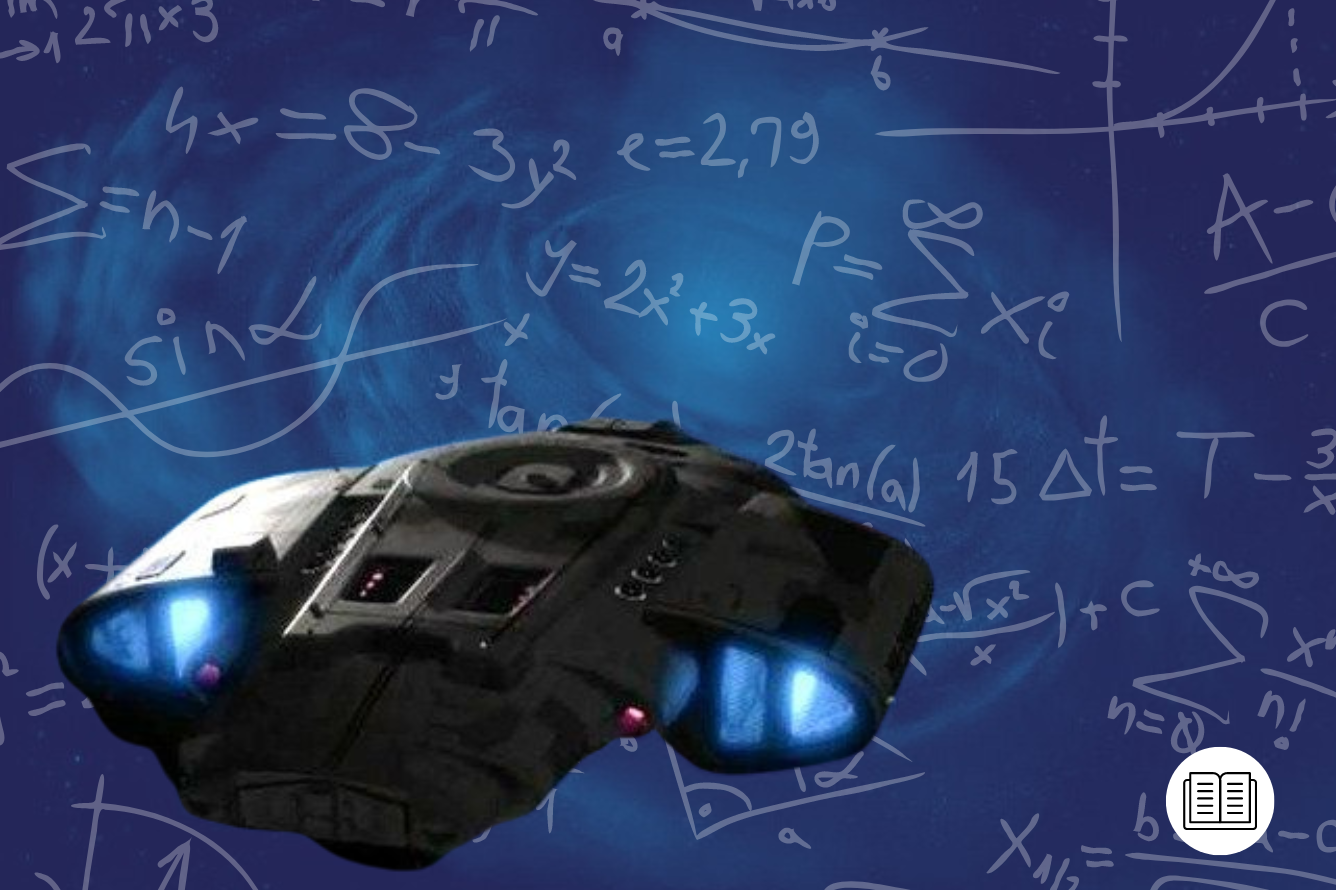Portals, wormholes, space-time distortions, time-space disturbances, and other space shortcuts are peppered throughout the Trek-iverse, enabling our favorite characters to travel to different places and times. But what I want to know is: when we venture further into the stars, how likely is it that we’ll find similar glowing gateways and winding wormholes for ourselves?

Portals are central to many Star Trek stories. One of the earliest, and most memorable, shows up in Star Trek: The Original Series. “Are you machine or being?” James T. Kirk (William Shatner) asks the large, glowing ring-shaped thing in front of him in possibly the greatest episode of The Original Series ever written: ‘The City on the Edge of Forever’ (S1, Ep28).
“I am both… and neither. I am my own beginning, my own ending,” replies the ring-shaped thing, which Kirk learns is called the Guardian of Forever, a portal that shows past events on its edges – I like to think of it as one of those Amazon Echo Show smart screen devices but much bigger with added time travel specs.
In a rather dramatic fashion, we soon find out that the Guardian of Forever doesn’t just display scenes from different times and places but can transport people to them. Because as moments from Earth’s past flash before the away team’s eyes, a delirious McCoy (DeForest Kelly) runs through the portal and is whisked off to 1930s New York, soon followed by Kirk and Spock.
Portals in Star Trek: Voyager, Deep Space Nine, and The Next Generation
One of my personal favorite portals is much less showy – mainly because it’s only about 30cm in diameter. It appeared in Star Trek: Voyager’s ‘Eye of the Needle’ (S1, Ep7) when the newly-hurled-across-the-galaxy crew of USS Voyager discovered a blue and green swirling, ancient and microscopic anomaly. I like this portal because it has one major twist. The crew thinks it’s a wormhole from the Delta Quadrant to the Alpha Quadrant, but it was from the Delta Quadrant to the Alpha Quadrant 20 years ago.
The only stable wormhole we encounter throughout Star Trek with few time discrepancies is the Bajoran wormhole in Star Trek: Deep Space Nine, which connects the Alpha Quadrant to the Gamma Quadrant. This portal looks cool, but it’s also a brilliant plot device, bringing much-needed drama to the space station and introducing a fascinating concept – that extra-dimensional beings can live inside it.

Although not much to look at, the Iconian Gateways are also interesting portals that show up across several Trek series. Like doorways with glittering edges, they provide access to different places. In Star Trek: The Next Generation’s episode ‘Contagion’ (S2, Ep11), we learn that these were created by a race called the Iconians hundreds of thousands of years ago as a method of transport so they could move throughout the galaxy without starships. “Crossing light-years as easily as we cross a room,” Picard says as he beholds one of the gateways for the first time.
Portals in Popular Culture
Those are just a few examples, but they show that portals and wormholes add tension and excitement, allowing characters to instantly travel vast distances and sometimes even take a trip to the past. That’s why it’s no surprise they show up in many science-fiction stories, including the TV show Rick & Morty – who else is desperate to take Rick’s portal gun for a spin? – the video game Portal, Stargate SG-1, and many, many more.
Similar gateways and portals show up beyond space-faring stories, too. Just take a look at the wardrobe in the C. S. Lewis classic The Lion, The Witch, and The Wardrobe (1950); the subtle knife that’s used to carve a doorway from one world to another in Phillip Pullman’s His Dark Materials trilogy (1995-2000); or the character Door’s portal-creating abilities in Neil Gaiman’s Neverwhere (1996).
The Theory of Traversable Wormholes
But is the idea that you could find a glowing ring and step through it to find yourself on the other side of the galaxy or even in another century rooted in any IRL science?
To find out, I spoke to physicist Diandian Wang, who works at the Department of Physics, University of California, Santa Barbara and specializes in wormholes and black holes. Wang said we need to begin by getting clear on the terminology, as there isn’t only one type of portal.
“If there’s a portal where a person can enter from one side and exit from the other, it’s called a traversable wormhole,” Wang explains. But there are non-traversable wormholes, too. “These are also portals,” he says. “But the kind where two people enter from two different sides can meet inside, but neither can get out.” When we’re talking about traveling through space and time, it’s the traversable ones we’re referring to.

There are also different traversable wormholes – both short and long ones. The short ones take you less time to travel through than going around them. In contrast, the long ones take just as long or even longer.
Wang explains the difference in commuting terms. “You would want to use a short traversable wormhole to travel to work because it’s a ‘shortcut’”, he says. “But with long ones, there’s no point unless you just want to enjoy different scenery at the expense of spending longer on the road.”
However, at least for now, this is all theoretical. “There’s no experimental evidence for the existence of traversable wormholes in our universe,” Wang says.

One of the main reasons we don’t know if portals like this exist is because there isn’t a way to produce them – unlike, say, black holes. “Black holes commonly exist in our universe because they form due to very heavy stars imploding onto themselves due to strong gravity,” Wang says. “There is no similar process for traversable wormholes – not one that’s believed to be common.”
Wang has played a part in research alongside a team from The University of California, Santa Barbara, and the University of Cambridge to produce a paper called ‘Creating a traversable wormhole’. They proposed a theoretical method of making a traversable wormhole. However, Wang tells me: “At the same time, it showed that it’s almost impossible to achieve in practice.”
He says another reason we don’t have evidence of portals is, if they do exist, they’d be tiny – even tinier than the one discovered in Star Trek: Voyager’s ‘Eye of the Needle’ (S1, Ep7). “Even if they are created by a quantum process, like the one described in our work, they’re typically of Planckian scale in size (10^-35 m), which is too small to detect by any realistic experiments.”
Time Travel and Wormholes
Now, the big question: if these wormholes exist, if we found evidence, might they work in the same way we see them working in Star Trek and other science fiction? “Theoretically, short, traversable wormholes allow one to suddenly – or quickly compared to conventional means – travel to another galaxy,” Wang says.
We see this from Star Trek: Deep Space Nine’s Bajoran wormhole or the Iconian gateways. They enable travel through space. But things get more confusing when we’re also dealing with travel through time – like the kind of portal imagined as the Guardian of Forever.

Wang says wormholes may have another added feature: travel to the past. As we learned in our exploration of time travel in Star Trek, the problem is the causality paradoxes that nipping back and forth through time would cause. Like the idea you could travel back in time and kill your grandfather (the grandfather paradox). Because if you could, would that also kill you? And if it did, how did you get back in time to do it if you never existed in the first place? “This breaks physics,” Wang says.
“These wormholes are forbidden in any reasonable theory that respects causality,” Wang says, which is the idea that causes happens before effect.
“Any science fiction that uses wormholes for fast traveling or going back in time is not scientific and inconsistent with current physics theories, like General Relativity, String Theory, etc.”
But long traversable wormholes are a different story. “They are perfectly allowed in theory, although they may be hard to create in practice,” Wang tells me.
“If a sci-fi story claims that an advanced civilization can easily create them using their hyper-developed technology, it does not violate any physics laws, and I would totally believe it.”
But hold up, why would anyone – no matter how advanced – do to the trouble of creating a longer way to travel vast distances? Well, Wang says that these wormholes aren’t all that helpful by their very definition. But did offer some examples of how they might be used – all centered around a Star Trek-worthy heist. “An intergalactic thief might want to use one of these long traversable wormholes to escape after stealing some valuable resources from a foreign galaxy,” he tells us.
“The entrance to the wormholes might be made small so that the local police can hardly locate them – but maybe intergalactic policemen can.”
This article was first published on May 25th, 2022, on the original Companion website.
The cost of your membership has allowed us to mentor new writers and allowed us to reflect the diversity of voices within fandom. None of this is possible without you. Thank you. 🙂









